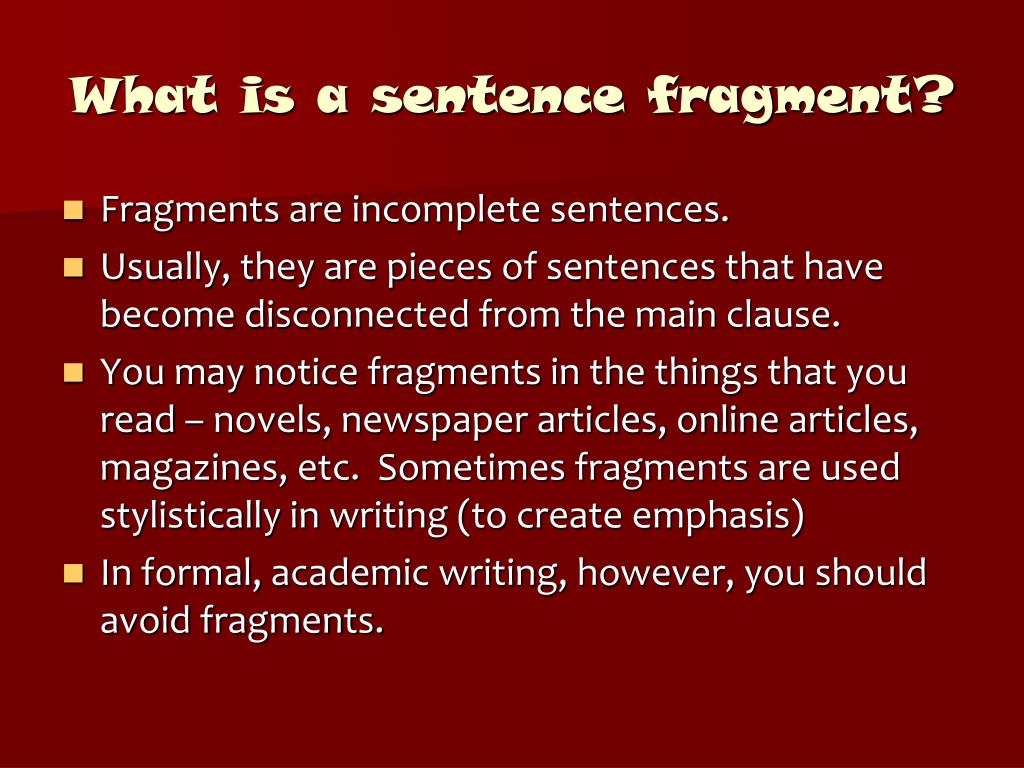


The rings spinning on the curtain rod when she pulls the curtain down with her.

In the following example, Don Delillo, in his novel Point Omega, uses fragments to allow readers to have a shared observation with the character narrating the story, who is viewing a silent, protracted scene from the movie, Psycho:
#Sentence fragments professional
In these situations, intentional fragments would likely stand out as awkward and unprofessional, possibly even flippant.īut professional writers do use intentional fragments in a wide variety of genres, including news articles, blog posts, works of fiction and creative nonfiction, advertisements, presentation slides, campaign slogans, product descriptions, and many others.įiction authors use fragments to create images, to be suggestive and evocative, creating moods and allowing readers to form their own impressions. Writers don’t often use fragments in formal writing, such as academic essays, government memos, letters of official business, product documentation, etc. Unless I win the lottery, I’ll be working here for another twenty years. Revision: I’ll be working here for another twenty years unless I win the lottery. I’ll be working here for another twenty years. Often, a dependent clause fragment can simply be tacked on to a nearby sentence: The fragment might also have been fixed by simply removing the subordinating conjunction: To complete the sentence, we changed the period to a comma and added an independent clause. Revision: After my wife got promoted, I quit my job. ( After is the subordinating conjunction) The following fragment contains a subject and a verb, but the attached subordinating conjunction creates a dependent clause, which means it can’t stand on its own:įragment: After my wife got promoted. Fragments with Subordinating Conjunctions To fix the fragment, we added the subject Antonio and the verb bowls. Revision: Antonio bowls every weekday and sometimes on weekends.

(Here, the entire gerund phrase functions as the subject of the sentence) Missing a Subject and a Verbįragment: Almost every weekday and sometimes on weekends Just sitting there doing nothing is bad for your health. In that case, we need to add only a verb to fix the fragment: It’s possible the writer wanted the fragment to function not as a participial phrase, but as a gerund phrase. Here, we connected the fragment to the preceding sentence with a comma because the fragment was meant to function as a participial phrase-It was meant to add more detail to the subject, Carl. Revision (b): Carl was frozen on the sofa, zombie-like, just sitting there doing nothing. Knowing the context can help us better solve the problem.Ĭontext in which the fragment occurred: Carl was frozen on the sofa, zombie-like. Note: Sitting in the example above might actually be intended to function as a participle, rather than as part of a present progressive verb construction. Here, we’ve added the subject Carl and the auxiliary verb was to make a complete sentence. Revision (a): Carl was sitting there doing nothing. This fragment is missing both a subject and a verb. To fix the fragment, we added the subject Rudy to make a complete sentence. Possible revision: Rudy was sleeping all day. In this revision, we’ve added the verb cried to complete the sentence. Possible revision: The gray clouds cried a sorrowful rain. Examples of Sentence Fragments Missing a Verb The best choice for revision depends on the context and the writer’s intention. There are two ways to fix a fragment: you can turn it into a sentence or attach it to a nearby sentence. A sentence fragment might also be a stand-alone dependent clause. A sentence fragment is an incomplete sentence-that is, it doesn’t express a complete thought-because it is missing a subject, a verb, or both.


 0 kommentar(er)
0 kommentar(er)
